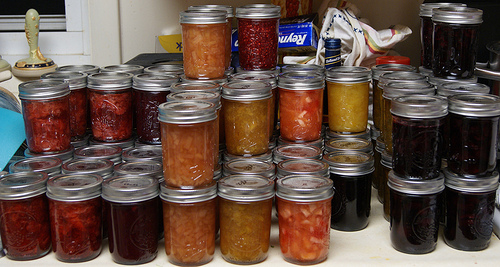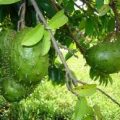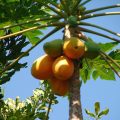Making fruit jams and jellies at home can bring big savings and additional income to the family. The best time to make fruit jam is when they are abundant or when they are in season. Fruit jams and jellies can be sold to your friends, neighbors, food shops, restaurants, supermarkets and food bazaars.

Mango Jam
In preparing mango jam, don’t use metal utensils like knife, casserole or other similar metal containers of the jam produced.
Procedure:
1. Wash rip mangoes, slice and scrape the flesh.
2. Pass through a course strainer.
3. For every 2 cups mango, add 1 cup sugar.
4. Cook in a heavy aluminum casserole or frying pan and keep on stirring until thick.
5. Keep in jars that had been sterilized (or exposed to the heat of the sun) and cover.
Mango-Tomato Jam
Materials:
Ripe mangoes, Ripe tomatoes, Sugar
Procedure:
1. The mango fruit is peeled and mashed after removing the seeds.
2. Blanch the tomatoes, remove the seeds and chopped finely.
3. Combine the mashed tomato and mango.
4. Add 11/2 cup sugar for every 2 cups of the mashed mixture. Then cook the mixture.
5. Cooking the mixture should be done until thick and transfer while hot to well sterilized jars and sealed tightly. Boil again for 20 minutes.
Coco Jam
Ingredients:
4 cups coconut milk
2/3 cup glucose
1/2 cup brown sugar
1 cup palm sugar (panutsa), crushed and chopped
Procedure:
1. Put coconut milk and glucose in a saucepan. Bring to a boil, mixing continuously.
2. Add brown sugar and panutsa when mixture boils. Reduce heat and stir until mixture becomes thick. Turn off heat and let cool.
3. When completely cooled, transfer into sterilized airtight jars.
Duhat Jelly
Note: Use only ripe duhat fruits.
Procedure:
1. Wash fruits, remove stems.
2. Boil in a little water for about 3 minutes.
3. Remove from fire and mash with a wooden spoon.
4. Put the cooked pulp in a cloth bag, strain.
5. Add a tbsp. calamansi juice and 1 cup sugar for every cup of duhat juice.
6. Stir well to dissolve sugar, strain again.
7. Cook again until all small bubbles disappear and the big bubbles seem to jump out.
8. Remove particles on top and pour into containers.
Papaya Jam
Materials:
4 cups mashed ripe papaya
3 1/2 cups sugar
1/3 cup kalamansi juice
Procedure:
1. Ripe papaya is peeled and the seeds removed. The clean papaya is mashed to a fine pulp.
2. Strain through a coarse perforated strainer and measure.
3. Boil gently, add sugar and kalamansi juice, continue boiling until desired consistency is obtained.
4. Transfer in sterilized bottles.
Guava Jam
Materials:
Ripe guavas, Sugar
Procedure:
1. Ripe fruits are washed, peeled and the seeds removed.
2. The fruits are mashed. To one part of the mash add 1 part sugar. Boil mixture gently until thick. To avoid unnecessary caramelization, kalamansi juice is added as in mango jam.
3. While still hot, pack in well sterilized jars and seal tightly.
Santol Jelly
Procedure:
1. Blanch santol in boiling water for 5 minutes.
2. Cut crosswise, remove seeds and cut pulp into small pieces 1/8-inch thick. Combine seeds and cut pulp.
3. Cover with hot water using 2 cups for every quarter of cut fruit.
4. Boil slowly for 20 minutes.
5. Strain through a jelly bag.
6. The method of cooking for “jellying” point is the same as for any fruit jelly.
Guava Jelly
Materials:
mature guava (not so ripe)
calamansi
sugar
denatured alcohol (for testing)
Utensils:
aluminum casserole
wooden spoon
sinamay for straining
muslin cloth
measuring cup
jars
Procedure:
1. Wash the guavas, remove ends.
2. Slice into small pieces, put in a container with the fruits slightly immersed in water.
3. Boil in low fire until soft for about 12-15 minutes.
4. Wrap in wet muslin cloth, twist the cloth to draw out the juice a little, but not the pulp.
5. Test the pectin content. Put one tablespoon juice in 2 tbsp. denatured alcohol. If it becomes turbid, the pectin content is weak; if it is rich in pectin, it will form solids.
6. To test the acidity, put 1 tbsp. calamansi juice in 8 tbsp. water. If this is too sour, add papaya or melon juice. If not, add some more calamansi juice.
7. Add 1 cup sugar for every cup juice. Stir well to dissolve the sugar.
8. Boil and filter again to remove foreign particles or undissolved sugar.
9. Boil well without stirring until the thickness of jelly is attained.
It is jelly if:
a) the temperature on top is 104°C-105°C.
b) dip a teaspoon into the mixture. If when it is drawn out, the syrup is like fiber, it is already jelly.
c) drop 1½ tsp. of the mixture into a glass of water. If the drop falls to the bottom and does not spread, it is jelly.
10. Let the bubbles disappear or filter them out with the help of the sinamay strainer before pouring into jars.
11. Cool a little. Poor dissolved candle on top of the hardened jelly. If the jar is new, the candle is not necessary, as new jars have a rubber lining that seals the jar tightly.
12. Close the jar and store in a cool dark place.
NOTE: Other fruits rich in pectin are: anonas, guayabano, granada, papaya, rimas, banana, santol, chico, sineguelas and tomato among others.
Sources: FNRI 1989, Health & Home Vol. 13(4), ITDI (DOST), yummy magazine







wewes
yamyamyam sir. kaw na
iba ka ?
hmmmm. intresting